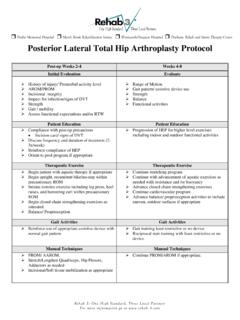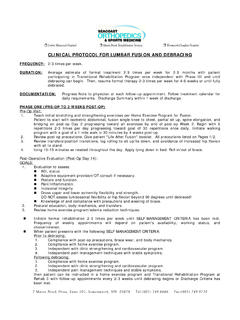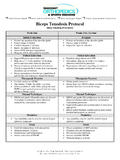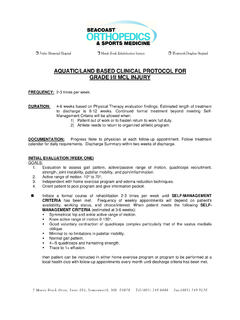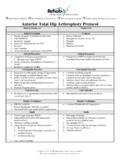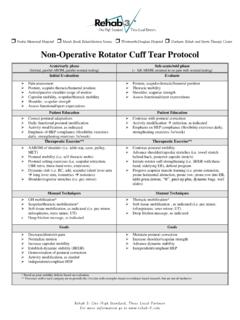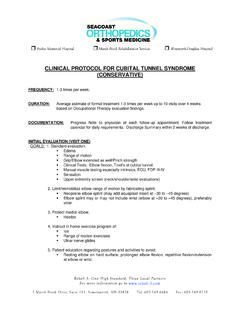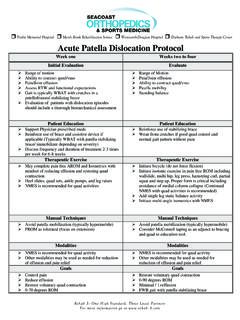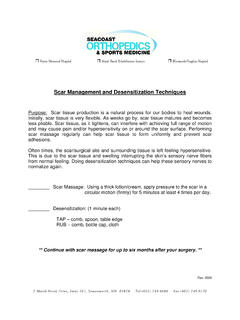Transcription of Lumbar Spondylolysis and Spondylolisthesis Protocol
1 Lumbar Spondylolysis and Spondylolisthesis Protocol Initial Evaluation Evaluate Hx: Spondylolysis rest and protect Is it Acute traumatic vs repetitive stress Spondylolysis due to hyperextension? o Can be unilateral or bilateral occurring L5 vertebrae between 85-95% of the time; L4 5-15% of the time. Most are unable to identify any particular traumatic incident Twice as common in male verse females Genetic predisposition- seen within families (1st degree relatives) Is Spondylolisthesis present? Is it from Spondylolysis or degenerative Spondylolisthesis ? o Degenerative slippage seen at L4 o Rarely seen under age 40 o Progression of Spondylolisthesis after age of 20 is much less common compared to progression during childhood and adolescence. Degree of anterolisthesis present may be of minimal clinical importance, degree of LBP experienced has good correlation with the degree of instability Prominent instability with minimal anterolisthesis is more problematic then stable segments with prominent anterolisthesis.
2 Imaging Xrays, flexion/extension, oblique o CT/MRI Instability with segment? Pain: Chief Complaint LBP seen in 47% of adolescents who have spondylosis and 5% adults. Location: Low back pain with radiculopathy (leg pain); pain down one or both legs especially with extension positions; Gluteals and posterior aspect thighs Spondylosis: Asymptomatic in majority of people. o Active and inactive lesions: can be incidental finding Back pain in child/adolescence raise suspicion newly developed or impending Spondylolysis Phase 2 static stability +1-4 weeks Review HEP o Pain management o Neutral spine with daily activities o Core bracing techniques If patient wasn t braced initially are they a candidate for bracing? o If rest and activity modification wasn t successful for pain management Re-assess neuro system o Better /worse/same?
3 Joint mobility o Above and below site (hip and thoracic spine) Soft tissue restrictions locally or regionally due to potential compensation Range of motion o Full UE and LE range of motion w/ neutral spine o Especially athletes 15-47% of the population in sporting activities that involve hyperextension and rotation such as gymnastics, diving, wrestling, dancing, throwing sports, soccer and baseball. Adults: look for concurrent instability with Spondylolysis Low back pain usually worse with extension; most common symptom o Aggravated with lifting or walking o Relieved with sitting Posture: Child/adolescents: visual inspection may reveal hyperlordosis Adult: Focal kyphosis at lumbosacral junction with exaggerated Lumbar lordosis Palpation: Paraspinals muscle spasm Tender to palpation spinous process Flexibility: Contracture/tight hamstrings Tight hip flexors Gait: Flexed hips and knees Stiff legged, short stride, pelvic waddle ROM: Limited/restricted active and passive motion Neuro: more seen in Spondylolisthesis Lumbar radiculopathy (irritation, stretching, compression of the nerve root foramen): leg Numbness, tingling, weakness.
4 O Assess dermatomes, myotomes, reflexes o Central canal stenosis neurogenic claudication o cauda equina (higher grades Spondylolisthesis ) bowel and bladder changes neural tension o Special tests: Step off deformity (high grade Spondylolisthesis ) Limited SLR Pain with one legged standing Lumbar extension test Patient Education Patient Education HEP Log rolling HEP Avoiding hyperextension Abdominal bracing Activity modifications/restrictions: avoiding hyperextension and rotation o Rest 8-12 weeks acute Spondylolysis Lifting techniques If in sports no sports Good lifting mechanics Therapeutic Exercise* Therapeutic Exercise* Phase 1: rest and/or protect; first ~8-12 weeks for acute Spondylolysis / Spondylolisthesis , week 0 degenerative Spondylolisthesis General exercise o light stationary biking, TM walking with incline, Nustep Strengthening deep abdominal muscles and back muscles (transverse abdominis and multifidi) o abdominal bracing (multiple positions)- be sure not over recruit w/ superficial abdominal muscles Stretching in neutral positions (supine 90/90 active knee extension hamstring stretch, piriformis stretch, sidelying quad/hip flexor stretch)
5 O avoid hip flexor based strengthening Pain control o Nsaids o Analgesics o Injections-after 4-6 weeks if other conservative measures fail Bracing o Usually not needed for most people, no clinical significant differences seen with wearing o Can be used to decrease Lumbar lordosis and manage pain if 2-4 weeks of rest/activity modification alone don t reduce pain. o Worn 23 hours/day for 6 months Modalities o Low intensity pulsed ultrasound (LIPUS) Early studies thus far have been promising for increasing healing times frames especially with progressive stage fractures. Heat/ice TENS Phase 2: static stabilization weeks +1-4 general exercise: o light to moderate stationary biking; deep water jogging with floats bridges, sidelying hip abd, clamshells, side plank, UE/LE movements with abdominal bracing start supine/sitting and progress to standing exercises (hip abd, hip extension, marching, pull downs, rows) Progression criteria: pain free static exercises, pain free Lumbar flexion or lateral flexion, maintain neutral spine with LE/UE movements.
6 Manual Techniques Manual Techniques Stretching hip flexors/hamstring (keep hip mobility intact) Dry needling pain relief Thoracic manipulation for pain relief Gentle STM to paraspinals/other tender areas based on palpation Segmental traction for pain relief Continue stretching PRN STM any muscular restrictions/pain Joint mobilization grd 1-2 for pain alleviation thoracic spine; manipulation for global pain modulation and neuromuscaular facilitation Dry needling pain relief Goals Goals Independent with pain management strategies o pain free daily activities Independent with HEP (general exercise, core bracing, neutral spine, gradually increase flexibility upper and lower extremities) Understanding importance of activity restriction/modifications- avoiding hyperextension Maintain pain free (nearly) range, pain free daily activities, increase core strength, normal hip and thoracic mobility, progress flexibility and Lumbar stabilization to WB postures, improve proprioception.
7 * Exercises within each category are to provide the clinician with examples based on evidence based research, but are not all inclusive Evaluate Evaluate Phase 3: dynamic stabilization; +4-6 Is patient progressing as expected? ROM spine o Progressing towards full range, no restrictions Joint mobility o Progressing towards normal mobility globally Soft tissue o Decreased protective tone, restore normal tension Neuro screening WNL o If persistent neuro- referral out? Is Non-union/instability present? Precautions: avoid prolonged pain with initiation Lumbar extension AROM Progression criteria: no increase in pain with Lumbar range of motion. Phase 4: coordination, athletic development; +6-8 ROM: spine/UE/Le should be WNL Joint mobility- WNL Soft tissue- no restrictions Neuro - WNL Progression criteria: pain free with all motions Phase 5: return to sport +3-6 months Precautions: may need to be cautious with returning to Olympic lifting (power lifting) Patient Education Patient Education Pain management with increased Lumbar range of motion Importance of good mechanics with high level activities Therapeutic Exercise* Therapeutic Exercise* General exercise: mod intensity stationary biking or elliptical machine, shallow water (chest deep water) Suggested exercises: single leg brides, plank, squats/hip hinge, upper body lifting w/ spine neutral, lunges, oblique rotations starting in HL/supine, OH reaching.
8 Phase 4: Suggested exercises: chopping/lifting patterns (diagonals), body weight suspension exercises TRX, progression impact loading (sport specific), gradual exposure to sport specific activities/drills Phase 5: Suggested exercises: squats with medicine ball throw/rotations, single leg DL with weight, front squat, lunges with twist, hip sleds, plyometrics, abdominal workouts, sports specific exercises. Manual Techniques Manual Techniques Joint mobilizations/manipulation pain relief, mobility, neuromuscular facilitation Dry needling pain/neuromuscular facilitation STM Stretching PRN Joint mobilization grade 3-4 mobility Dry needling STM Stretching PRN Goals Goals normal joint mobility in thoracic spine and hip, resume Lumbar extension NWB, maintain flexibility, and continue increasing strength and coordination.
9 Phase 4: maintain strength and flexibility, Lumbar extension in WB, impact loading Phase 5 Goals: full participation in sports * Exercises within each category are to provide the clinician with examples based on evidence based research, but are not all inclusive References Crawford III, C. H., Ledonio, C. G., Bess, R. S., Buchowski, J. M., Burton, D. C., Hu, S. S., .. & Sanders, J. O. (2015). Current evidence regarding the etiology, prevalence, natural history, and prognosis of pediatric Lumbar Spondylolysis : a report from the scoliosis research society evidence-based medicine committee. Spine deformity, 3(1), 12-29. Ebraheim, N., Elgafy, H., Gagnet, P., Andrews, K., & Kern, K. (2018). Spondylolysis and Spondylolisthesis : a review of the literature. Journal of orthopaedics. Gr dahl, L. H. J., Fawcett, L.
10 , Nazareth, M., Smith, R., Spencer, S., Heneghan, N., & Rushton, A. (2016). Diagnostic utility of patient history and physical examination data to detect Spondylolysis and Spondylolisthesis in athletes with low back pain: a systematic review. Manual therapy, 24, 7-17. Haun, D. W., & Kettner, N. W. (2005). Spondylolysis and Spondylolisthesis : a narrative review of etiology, diagnosis, and conservative management. Journal of chiropractic medicine, 4(4), 206-217. Mai, H. T., & Hsu, W. K. (2015). Management of sports-related Lumbar conditions. Operative Techniques in Orthopaedics, 25(3), 164-176. Mataliotakis, G. I., & Tsirikos, A. I. (2017). Spondylolysis and Spondylolisthesis in children and adolescents: current concepts and treatment. Orthopaedics and Trauma, 31(6), 395-401. McNeely, M. L., Torrance, G., & Magee, D. J.
